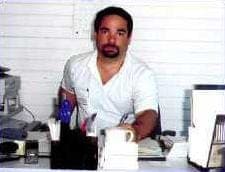
-----
What's best for etching "scenes" into aluminium?
1999
Q. Somebody, please help!
I am a year 11 student, completing a year 12 subject called studio arts. In this subject we have CATS, Common Assessment Tasks. For my first CAT, I designed a Battle Axe, made a pattern, and then cast the head of the axe in aluminium. Once polished, we thought the best thing to do was etch scenes from the Bayeux Tapestry onto it.
We used wax to seal it, and then caustic soda ⇦liquid caustic soda in bulk on
Amazon [affil link]
to etch it. The problem was it lifted the wax in places, and did an ok job, but it could have been better.
I'm about to complete my second CAT, which is now another axe, and a broad sword.
Could you please tell me the best thing to use to seal the aluminium (I've heard something of 'photoresist,' but I don't know what it is or where to get it or how to use it), and what the best substance is to etch the aluminium, and where would I get it from?
Your help would be greatly appreciated, thank you
from Lee
P.S. It's all due in in less than a week and a half, so a fast response would be great, thanks.
Australia
A. Hi Lee. Before talking about your project, it's probably a good idea to remind the readers that "etching aluminum" can mean different things to different people, so "what's best" for your etching project may be different from what's best for etching aluminum for metallography work, or etching aluminum to give it a grain to hide fingerprints, or etching aluminum to make shaped components by removing the aluminum where you don't want it. caustic soda ⇦liquid caustic soda in bulk on
Amazon [affil link]
is probably the most aggressive material to use for rapid action, and is often used to completely dissolve away aluminum (for example, hollow parts can be made by electroforming them onto an aluminum mandrel then dissolving away the aluminum. I hope you are using caustic only under the supervision of a science teacher because one drop of caustic in your eye could leave you blind.
Photoresist is a masking material that is photosensitive. It's widely used in printed circuit board manufacturing to help create circuit lines of copper plating separated by unplated or etched away bare epoxy circuit board. In practice you spray or brush your article with it, or apply it as a dry film sheet, and then project a pattern onto it with an ultraviolet light projector. Areas that have been exposed to the light will wash away with certain chemicals while the areas that have not been exposed will remain (or vice versa depending on whether it's a positive or negative photoresist).
If you have the patience to do careful cutting, a mask that should hold up is good old black vinyl electricians tape. "Platers tape" is pretty much the same thing, only heavier gauge. Teflon tape can work fine as an etch resist too if there is a practical and useful way of holding it in place on your axe.

Ted Mooney, P.E.
Striving to live Aloha
finishing.com - Pine Beach, New Jersey
Ted is available for instant help
or longer-term assistance.
1999
A. Lee, If you try to etch too deep you will get channeling under the masking. There really isn't much you can do about it since you will be dissolving the sides of the layers under the masking as fast as the pattern. We use sandblasting to etch patterns in Aluminum all the time and it works great. Just mask off the areas you don't want etched and go to town. Just watch the masking for signs of wear and use a relatively low blast pressure. Your school shop may even have a sandblast cabinet, or I have seen small decorative sandblasting kits at hobby stores. Good luck!

Jim Conner
Mabank, Texas USA
1999
A. Hi again, Lee. Jim is probably right that sandblasting is a better way to etch in Lee's situation than using chemicals.
Regards,

Ted Mooney, P.E.
Striving to live Aloha
finishing.com - Pine Beach, New Jersey
Ted is available for instant help
or longer-term assistance.
August 2013
Q, A, or Comment on THIS thread -or- Start a NEW Thread